Expression of a homologue of a vertebrate non-visual opsin Opn3 in the insect photoreceptors
- PMID: 36058246
- PMCID: PMC9441228
- DOI: 10.1098/rstb.2021.0274
Expression of a homologue of a vertebrate non-visual opsin Opn3 in the insect photoreceptors
Abstract
Insect vision starts with light absorption by visual pigments based on opsins that drive Gq-type G protein-mediated phototransduction. Since Drosophila, the most studied insect in vision research, has only Gq-coupled opsins, the Gq-mediated phototransduction has been solely focused on insect vision for decades. However, genome projects on mosquitos uncovered non-canonical insect opsin genes, members of the Opn3 or c-opsin group composed of vertebrate and invertebrate non-visual opsins. Here, we report that a homologue of Opn3, MosOpn3 (Asop12) is expressed in eyes of a mosquito Anopheles stephensi. In situ hybridization analysis revealed that MosOpn3 is expressed in dorsal and ventral ommatidia, in which only R7 photoreceptor cells express MosOpn3. We also found that Asop9, a Gq-coupled visual opsin, exhibited co-localization with MosOpn3. Spectroscopic analysis revealed that Asop9 forms a blue-sensitive opsin-based pigment. Thus, the Gi/Go-coupled opsin MosOpn3, which forms a green-sensitive pigment, is co-localized with Asop9, a Gq-coupled opsin that forms a blue-sensitive visual pigment. Since these two opsin-based pigments trigger different phototransduction cascades, the R7 photoreceptors could generate complex photoresponses to blue to green light. This article is part of the theme issue 'Understanding colour vision: molecular, physiological, neuronal and behavioural studies in arthropods'.
Keywords: G protein; mosquito; ommatidium; rhodopsin; signal transduction; vision.
Figures
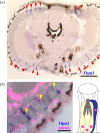
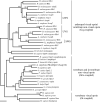
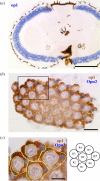
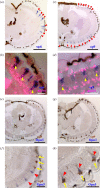
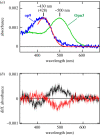
Similar articles
-
Homologs of vertebrate Opn3 potentially serve as a light sensor in nonphotoreceptive tissue.Proc Natl Acad Sci U S A. 2013 Mar 26;110(13):4998-5003. doi: 10.1073/pnas.1219416110. Epub 2013 Mar 11. Proc Natl Acad Sci U S A. 2013. PMID: 23479626 Free PMC article.
-
The evolution of red color vision is linked to coordinated rhodopsin tuning in lycaenid butterflies.Proc Natl Acad Sci U S A. 2021 Feb 9;118(6):e2008986118. doi: 10.1073/pnas.2008986118. Proc Natl Acad Sci U S A. 2021. PMID: 33547236 Free PMC article.
-
Unique Temporal Expression of Triplicated Long-Wavelength Opsins in Developing Butterfly Eyes.Front Neural Circuits. 2017 Nov 29;11:96. doi: 10.3389/fncir.2017.00096. eCollection 2017. Front Neural Circuits. 2017. PMID: 29238294 Free PMC article.
-
Diversity of animal opsin-based pigments and their optogenetic potential.Biochim Biophys Acta. 2014 May;1837(5):710-6. doi: 10.1016/j.bbabio.2013.09.003. Epub 2013 Sep 13. Biochim Biophys Acta. 2014. PMID: 24041647 Review.
-
Insect opsins and evo-devo: what have we learned in 25 years?Philos Trans R Soc Lond B Biol Sci. 2022 Oct 24;377(1862):20210288. doi: 10.1098/rstb.2021.0288. Epub 2022 Sep 5. Philos Trans R Soc Lond B Biol Sci. 2022. PMID: 36058243 Free PMC article. Review.
Cited by
-
High diversity of arthropod colour vision: from genes to ecology.Philos Trans R Soc Lond B Biol Sci. 2022 Oct 24;377(1862):20210273. doi: 10.1098/rstb.2021.0273. Epub 2022 Sep 5. Philos Trans R Soc Lond B Biol Sci. 2022. PMID: 36058249 Free PMC article.
-
Functional characterization of four opsins and two G alpha subtypes co-expressed in the molluscan rhabdomeric photoreceptor.BMC Biol. 2023 Dec 18;21(1):291. doi: 10.1186/s12915-023-01789-7. BMC Biol. 2023. PMID: 38110917 Free PMC article.
References
Publication types
MeSH terms
Substances
LinkOut - more resources
Full Text Sources

